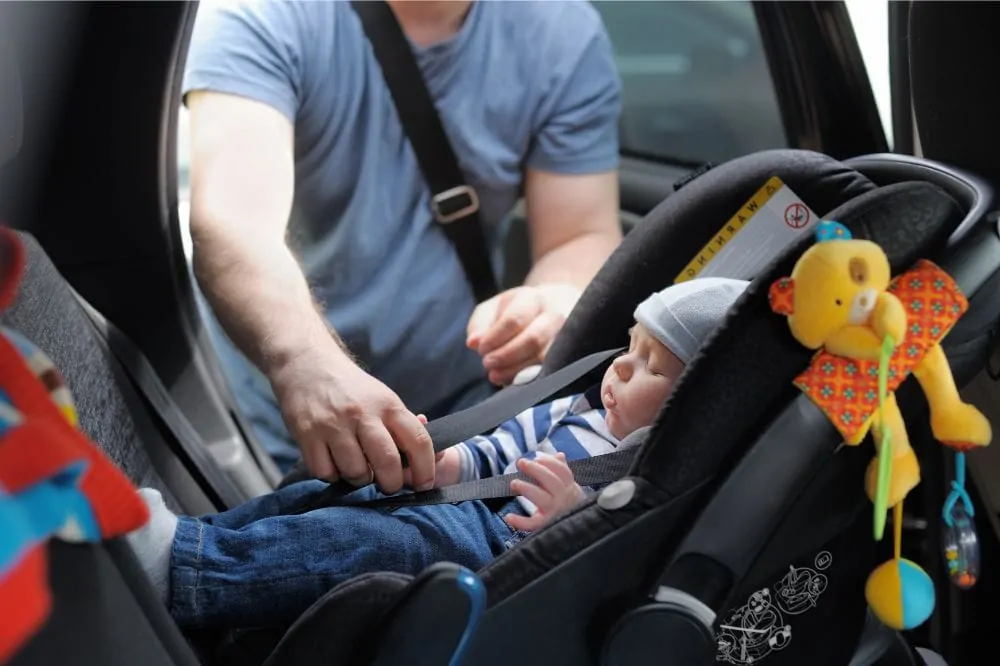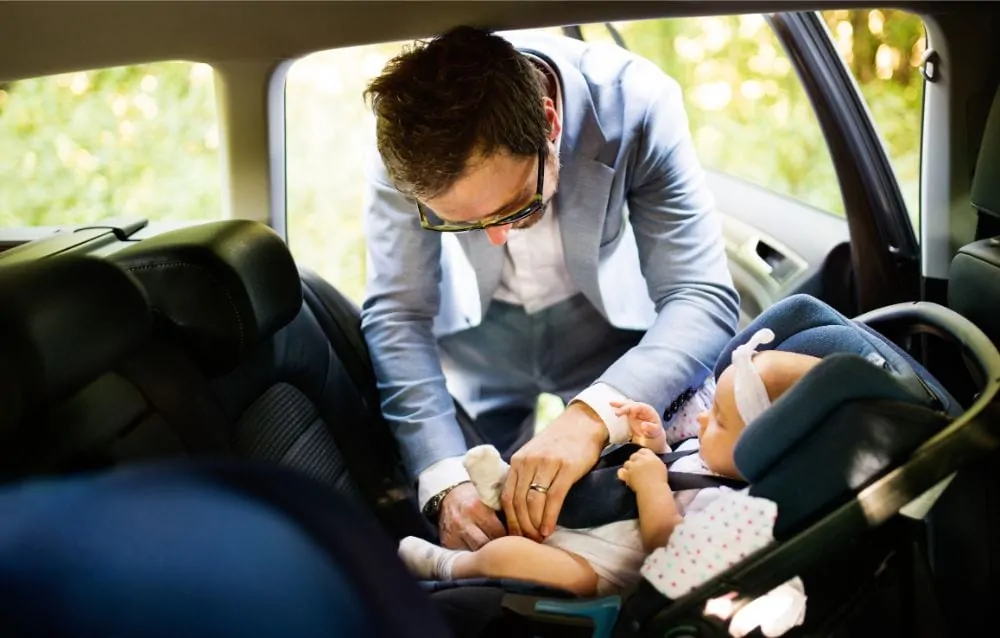Did you know that approximately 46% of car seats and booster seats are misused? That makes them almost ineffective in a crash (1).
Car seat safety is non-negotiable. But buying the seat is only step one. You also need to know the proper placement, how to buckle your child correctly, and exactly when to upgrade.
We have the car seat safety tips you need to protect your little passenger on every trip.
Key Takeaways
- Safety first: Properly installed car seats significantly reduce the risk of injury and fatality during accidents.
- Know your types: Use rear-facing for infants/toddlers, forward-facing for preschoolers (ages 2-7), and boosters for big kids (ages 8-12).
- Check the fit: Choose a seat that fits your specific vehicle and offers side-impact protection; never use a recalled or expired seat.
- Install correctly: Use either the LATCH system or the vehicle seat belt (never both unless specified) and always use the top tether for forward-facing seats.
Why You Should Use a Car Seat
You might be the safest driver on the road, but you cannot control other vehicles. Crashes happen instantly, and preparation is your only defense. Here are the statistics you need to know:
- Usage gaps: The CDC found that in a one-year study, 618,000 children rode without a car seat or booster at least once.
- Fatality risks: In 2020, 607 children under age 12 died in car crashes (2). Of the children killed who were buckled up, 35% were not restrained correctly.
- Injury rates: Approximately 63,000 children were injured in crashes in 2020 alone.
- Driver behavior: When a driver doesn’t wear a seat belt, there is a 40% chance their child is also unrestrained.
These numbers highlight a scary reality. Hearing your baby cry in the back seat is stressful. However, taking them out of their seat while the car is moving jeopardizes their life.
Proper restraints work. Between 1975 and 2010, car seats saved an estimated 9,611 lives (3).
Infants have heavy heads and weak necks. They are incredibly vulnerable to spinal injuries. The right car seat distributes crash forces away from these fragile areas and saves lives.
Car Seat Types
You cannot use the same seat for a newborn that you use for a kindergartner. Understanding the three main categories helps you choose the right protection for your child’s current stage.
1. Rear-Facing
Experts agree that rear-facing is the safest position for infants and toddlers (4). In a crash, a rear-facing seat cradles the child. It moves with the impact and protects the head and neck. This distributes force across the entire back rather than focusing it on seat belt contact points.
Do not rush to switch your child. Experts recommend you keep them rear-facing until they max out the height or weight limits of their specific convertible seat.
Most seats handle up to 40 or 50 pounds in this position. This keeps the average child rear-facing until age 3 or 4.
Check the height limit too. There should be at least 1 inch of clearance between the top of your baby’s head and the top of the seat shell. If there is less than an inch, you need to upgrade.
Here are the three variations of rear-facing seats:
1. Infant Car Seat
Infant car seats are portable carriers designed exclusively for newborns and smaller babies. You install a base in the car and click the seat in and out. Most babies outgrow these by weight (usually 30-35 pounds) or height within the first year or so.
2. Convertible Car Seat
Convertible car seats stay installed in the car. They start as rear-facing seats for babies and convert to forward-facing seats for toddlers. They have higher rear-facing limits than infant carriers.
3. All-in-One Car Seat
These are the long-haulers. An all-in-one seat starts rear-facing, switches to forward-facing, and eventually converts into a booster seat. They are a great investment if you want one seat to last for years.
2. Forward-Facing
Forward-facing seats use a five-point harness to secure your child. The harness straps go over the shoulders, around the hips, and buckle between the legs.
Most children use these seats between ages 2 and 7 (5).
Always check your specific model’s limits. Forward-facing harness weight limits usually range from 40 to 65 pounds, though some go higher.
Check the fit regularly. Your child’s ears should never reach above the top of the shell. The shoulder straps must sit at or slightly above their shoulders.
There are three common types of forward-facing options:
1. Convertible Car Seat
If you started with a convertible seat for your infant, you simply turn it around once they max out the rear-facing limits.
2. Combination Car Seat
This seat faces forward only. It uses a harness for smaller children and converts into a belt-positioning booster once the child is big enough.
3. All-In-One Car Seat
If you bought an all-in-one for your newborn, you will adjust the recline and installation method to use it in the forward-facing harness mode.
3. Booster Seat
Booster seats lift your child up so the vehicle’s seat belt fits correctly. They do not use a built-in harness.
Your child should stay in a booster until they are 4 feet 9 inches tall. This usually happens between ages 8 and 12.
There are two styles of boosters:
1. High-Back Booster
This creates a mini seat with a backrest and head support. It provides a belt guide to keep the shoulder strap in the right place. It is the best choice for younger booster riders or children who fall asleep in the car, as the wings prevent them from slumping over.
2. Backless Booster
A backless booster is a simple cushion that raises the child. It requires the vehicle seat to have a headrest to protect against whiplash. It is portable and great for older kids who just need a height boost.
Stay In The Back
How to Find a Safe Car Seat
Finding the perfect seat matters. If you are pregnant, buy your seat early. The hospital will not discharge you until your newborn is safely buckled up (7).
What You Need to Look for
Buying a car seat is stressful, but focusing on these features simplifies the process:
- Consider a convertible: Newborns turn into toddlers quickly. A convertible seat saves you money by adapting as your child grows, eliminating the need to buy a new seat after a year.
- Check vehicle fit: Not every seat fits every car. Measure your back seat space before buying. If you have a small car or need to fit three seats across, look for narrow models.
- Installation method: Decide if you prefer using LATCH (Lower Anchors and Tether for Children) or the seat belt. Most modern cars have LATCH, but weight limits apply.
- Harness ease: You will use the buckle multiple times a day. Make sure it is easy to tighten and loosen.
- Head support: Newborns need extra stability. Look for a seat with approved infant inserts. Never use aftermarket pillows or head positioners; they are unsafe.
- Fabric quality: Look for energy-absorbing foam for safety and removable covers for hygiene. You will want something easy to clean after the inevitable diaper blowout.
- Side-impact protection: Look for deep side wings and head barriers. These features provide crucial protection during T-bone accidents.
- Registration card: Always register your seat. This is the only way the manufacturer can contact you regarding safety recalls.
What You Need to Avoid
Some seats are simply unsafe to use. Watch out for these red flags:
- Expired seats: Car seats expire after 6 to 10 years. Plastic degrades over time. If you cannot find a date, do not use it.
- Missing labels: If a seat lacks a model number or manufacturing date, you cannot check for recalls. Skip it.
- Recalled models: Check the NHTSA database. If a seat has been recalled for safety failures, do not buy it.
- Visible damage: Cracks, stress marks, or frayed straps indicate compromised structural integrity.
- No manual: You need instructions for a safe install. If a secondhand seat has no manual, try to find a digital copy. If you can’t, do not use the seat.
- Missing parts: Never use a seat that lacks original components.
- Crash history: Never use a seat that has been in a moderate or severe accident. The damage may be internal and invisible (8).
Best Way to Install a Car Seat
You can install a car seat using either the LATCH system or the vehicle seat belt. Both are safe, but you usually cannot use them together. Read your manual carefully.
LATCH System
LATCH uses anchors built into your car’s seat crack to secure the car seat. Most vehicles made after 2002 have two sets in the back.
Here is the general process:
- Click the lower anchors: Locate the lower connector straps on your car seat. Click them onto the metal bars located in the vehicle seat bight (the crease between the back and bottom cushion).
- Tighten the straps: Press down firmly on the center of the car seat while pulling the LATCH strap tight to remove slack.
- Attach the top tether: For forward-facing seats, you must attach the top tether strap to the anchor behind the seat. This prevents head whip in a crash.
- The Inch Test: Grab the car seat at the belt path. Pull it side-to-side and front-to-back. It should not move more than one inch in any direction.
Seat Belt System
The seat belt method works in any seating position and has no weight limit restrictions.
Here is how to do it:
- Find the belt path: Check your manual to find the correct path for rear-facing or forward-facing installation.
- Thread and buckle: Route the seat belt through the designated path and buckle it. Ensure the belt is not twisted.
- Lock the belt: Pull the seat belt all the way out until it stops. Feed it back in slowly; you should hear a clicking sound. This engages the locking mechanism.
- Tighten and tether: Push down on the car seat and pull the shoulder belt tight to remove slack. If forward-facing, attach the top tether.
- Verify stability: Perform the Inch Test. The seat should not wiggle more than an inch at the belt path.
10 Safety Tips for Car Seats
Nearly half of all car seats are installed incorrectly. Follow these ten tips to ensure your child is truly safe:
1. Everyone Should Buckle Up
Safety is a family effort. If you are unbuckled in a crash, your body becomes a heavy projectile that can strike and kill other passengers, including your baby. Set the example. If the car is moving, everyone is buckled. No exceptions.
2. Don’t Distract Yourself
Focus on the road, not the baby. Texting, reaching back to hand out snacks, or adjusting mirrors to see your child takes your eyes off traffic.
If your baby is fussy, try these safe distractions:
- Check comfort first: Ensure straps aren’t pinching and the temperature is mild before you drive.
- Soft toys: Keep soft, plush toys nearby. Avoid hard toys that can become missiles in a crash.
- Time your drive: Plan long trips during nap times to increase the odds of a quiet ride.
3. Always Use the Tether Strap
When your child switches to forward-facing, the top tether is mandatory. It anchors the top of the seat to the vehicle.
Without a tether, a child’s head can fly forward an extra 6 inches during a crash. This significantly increases the risk of head and spinal injuries. Check your vehicle manual to locate the tether anchors in your car (usually on the seat back or rear shelf).
4. Place the Car Seat in the Middle
The center rear seat is statistically the safest spot because it is furthest from any side impact. However, the “best” spot is wherever you can get the tightest installation. If your middle seat has a hump or lacks anchors, use a side seat. A solid install on the side is safer than a loose install in the middle.
5. Keep the Straps Snug
Loose straps allow ejection. You should not be able to pinch any webbing at the child’s shoulder. This is called the “Pinch Test.”
Also, check the chest clip. It must sit at armpit level. If it is too low, the child can fly out of the straps; too high, and it can injure the neck.
6. Remove Heavy Winter Clothes
Puffy coats create a false sense of security. In a crash, the air in the coat compresses, leaving the harness too loose to hold the child.
Buckle your child in regular indoor clothes. Tighten the harness against their body, then put their coat on backward over their arms or cover them with a blanket to keep them warm without compromising safety.
Try layering your children’s clothing with long-sleeved shirts and a thin fleece jacket. Thin layers provide additional warmth without the bulk. Once your child is secure in the car, you can then place a blanket over them as well.
Editor's Note:
Kristen Gardiner, CPST7. Correct the Angle
Newborns have heavy heads and no neck control. If the seat is too upright, their head can flop forward and cut off their airway.
Most seats have a bubble level or line indicator. Ensure the ball is in the green zone or the line is parallel to the ground. If your car’s seats are sloped, you may need a pool noodle or rolled towel (if allowed by the manufacturer) to get the right recline.
8. Get the Installation Checked
Don’t guess. Visit a certified Child Passenger Safety Technician (CPST). They will check your install for free and teach you how to do it correctly. It is a small step that offers huge peace of mind.
9. Don’t Jump the Gun on Booster Seats
Maturity matters. A booster seat relies on the child sitting properly for the entire ride. If they slouch, lean over, or play with the belt, the protection fails.
Most kids are not ready for a booster until at least age 5 or 6 and 40 pounds. Use the 5-step test to know when they are ready to ditch the booster for a regular seat belt.
10. Car Seats Expire After a Crash
Car seats are one-and-done items. If you are in a moderate to severe crash, replace the seat immediately (9). Stress fractures in the plastic may be invisible to the naked eye. Many insurance companies will cover the cost of a replacement seat, so check your policy.


























